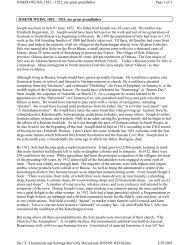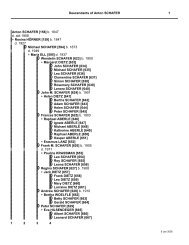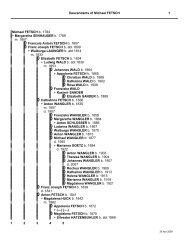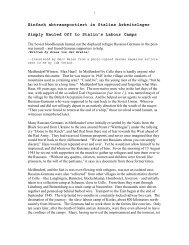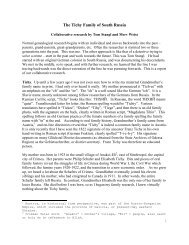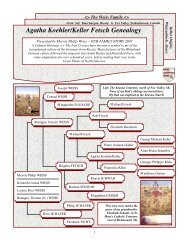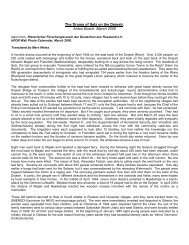ONCE IN A LIFETIME - RussianRoots.ca
ONCE IN A LIFETIME - RussianRoots.ca
ONCE IN A LIFETIME - RussianRoots.ca
You also want an ePaper? Increase the reach of your titles
YUMPU automatically turns print PDFs into web optimized ePapers that Google loves.
<strong>ONCE</strong> <strong>IN</strong> A <strong>LIFETIME</strong><br />
The expression “once in a lifetime” is perhaps over-used, but Sunday, 28 September was,<br />
for me, truly a once-in-a-lifetime experience. After all, a 200-year Jubilee <strong>ca</strong>n only occur<br />
once. The year 2008 marks the passage of two hundred years since the first Rhineland<br />
Germans ventured into the Kutschurgan Valley, Odessa district, having been enticed<br />
there by the promises of Czar Alexander I. The Germans built six villages there, which<br />
served as the foundation of their culture and Catholic faith for 136 years. The central<br />
economic and administrative center for those villages was the village of Selz, today<br />
<strong>ca</strong>lled Limanske. It lies 60 kilometers or 40 miles (straight-line distance) WNW of<br />
Odessa city center, nestled up against the big liman or estuary which connects to the<br />
marshy delta of the Dniester River. To the west, several miles across the water, is the<br />
Autonomous Transniester Republic of Moldova.<br />
Selz is special for me, be<strong>ca</strong>use it is the birthplace of my father’s parents. My<br />
grandparents married there and had three daughters before they emigrated to Canada in<br />
1913, the peak year of outward migration of Germans from South Russia. They sang in<br />
the choir of that great <strong>ca</strong>thedral, The Church of the Assumption, which today exists in a<br />
sad state of ruin and neglect. My grandmother’s direct ancestor, Michael Fetsch, was the<br />
first mayor of Selz, and her second cousin, Alexander Fetsch, was the last German mayor<br />
of Selz. Selz was home to the Weiss and Fetsch families for five generations before my<br />
grandparents, Konrad Weiss and Brigetta Fetsch, decided that the unknown of North<br />
Ameri<strong>ca</strong> was a better option than the growing turmoil of South Russia.<br />
Selz has survived, but it has endured much. Once considered the most prosperous<br />
German colony in Odessa district, the village today looks poor and beaten down, by<br />
North Ameri<strong>ca</strong>n standards. It still holds bitter memories for those Germans whose<br />
families remained behind. There are many yet who remember the onslaught of a new<br />
economic order in the 1920’s, the persecutions and banishments of the program to<br />
collectivize agriculture, the Holodomor or great famine of the 1930’s, Stalin’s great<br />
Terror <strong>ca</strong>mpaign of 1937/38, and the final abandonment of their villages in 1944. I <strong>ca</strong>n<br />
feel the burdens and pains of those years still today as I walk the streets of Limanske.<br />
The tired-looking homes still seem to weep for their former German inhabitants. The<br />
flocks of ducks and geese wander and quack and honk, as if they still wonder, “Where<br />
did they go?”<br />
Life in the small villages of South Ukraine is still mostly a subsistence livelihood, relying<br />
on the bountiful gardens and vineyards, and on those ducks and geese. But the promise<br />
of better economic times for Limanske <strong>ca</strong>n be seen in the new highway from Odessa, in<br />
the new and modern restaurant in which we ate, in the three wineries now operating in<br />
Limanske, and in the new regional airport being built to the east above the town.<br />
(Limanske, as a municipal entity, now incorporates the former German colonies of<br />
Baden, Selz and Kandel.)<br />
I was in Selz on Sunday, 28 September. This was my fourth visit to my ancestral village,<br />
and I now enjoy the comfort of familiarity when I am there. I was in Selz on this day as a
member of the Robert Schneider Tour Group, to help the village celebrate its twohundred<br />
year Jubilee. I remember reading Konrad Keller’s description of the<br />
Kutschurgan villages in 1908 when they celebrated the toils and accomplishments of 100<br />
years of German colonization. I imagined the pride the Selz people must have felt for<br />
their new and beautiful <strong>ca</strong>thedral. But throughout the day I could not quit thinking about<br />
the sad and tragic history of the second one-hundred years, as those Germans were beaten<br />
into serfdom and dragged through thousands of miles of Europe and Siberia and Asia.<br />
But this was 2008, and I was in Selz, and we were there to celebrate.<br />
Light rain throughout the day, following a week of rain, obscured the many preparations<br />
by the residents of Limanske to clean up their town, to clean up the church grounds, to<br />
put up anniversary banners and balloons. But it was obvious from the moment we<br />
arrived on Sunday morning that this was no ordinary day in Selz. People with and<br />
without umbrellas were wandering everywhere on the streets around the old church.<br />
Inside the church, several hundred people had gathered, waiting to celebrate Holy Mass.<br />
Once again, the Cathedral walls echoed with the liturgy and the songs of the Holy Mass<br />
in German and Latin. I was in a daze, as long-forgotten memories of those sounds<br />
surfaced and took me back to Fox Valley, Saskatchewan where I grew up. Incredibly,<br />
also inside this old <strong>ca</strong>thedral on this day were five Eresman siblings, members of another<br />
Fox Valley family. And as we received Holy Communion, how could we not think about<br />
our grandparents doing likewise in the very same spot.<br />
The church service may have started late, but the parade band struck out at precisely<br />
11:00 am, interrupting my reverie inside the church. We followed the band to the<br />
“Palace of Culture”, an old Soviet term for what we would <strong>ca</strong>ll a community theatre. An<br />
extensive program of entertainment interspersed with presentations and speeches would<br />
fill most of the afternoon. People stood in the aisles and entrances long after the five<br />
hundred seats had been filled. I was one of the several Guests of Honor, presented with<br />
the traditional loaf of bread and salt (<strong>ca</strong>lled korovai) on a cloth. I was interviewed by<br />
television and newspaper reporters from Odessa and Kiev, interested in speaking to a<br />
North Ameri<strong>ca</strong>n descendant of original Selz colonists. It was “my” day in Selz.<br />
What we in North Ameri<strong>ca</strong> do not realize is that the German presence in South Russia<br />
was never recognized by official Soviet history. Before 1991, children in the Limanske<br />
schools would not have learned that their village was built by Germans. After the<br />
Germans were forced to leave in 1944, families from elsewhere in Russia were forcibly<br />
re-lo<strong>ca</strong>ted to occupy the empty houses of Limanske. So the families living there today<br />
have no connections to the German history of their village. The recognition given to the<br />
Germans on this special day of celebrations in Limanske is all the more amazing, given<br />
that background.<br />
This recognition has come from the work of people like Luise Riesling. Born in Selz, but<br />
forced to leave in 1944, her life story mirrors that of thousands of Germans exiled to<br />
s<strong>ca</strong>ttered corners of the Soviet Union. A strong-willed woman, she returned to Limanske<br />
in the early 1990’s and re-claimed her family home. She lives today in the house her<br />
grandfather built, across the street from the Cathedral, with her daughter and
granddaughter. I had visited with Luise each of the previous two days, and she talked<br />
about her efforts to edu<strong>ca</strong>te the lo<strong>ca</strong>l municipal council about the German history of their<br />
town. The museum she has begun in a va<strong>ca</strong>nt classroom of the school has done much to<br />
help school children learn their lo<strong>ca</strong>l history, and has attracted many visitors from<br />
Germany and North Ameri<strong>ca</strong>. The number of out-of-country visitors to Limanske in the<br />
last five years has really grown, again reinforcing for the lo<strong>ca</strong>l people that another culture<br />
once lived in their town.<br />
Luise’s work lo<strong>ca</strong>lly has been validated by the writings of lo<strong>ca</strong>l author/historian Vladimir<br />
Jakovlovich Bukovsky, who has written three books, the latest about the Germans of<br />
Odessa District, particularly Selz, <strong>ca</strong>lled “Bitter Truth”. Luise also receives help from<br />
people like Alexei Köhler, Georg Moser, and Valentina Weisbeck, all of whom have<br />
various official responsibilities to represent the Germans who live in Ukraine.<br />
I <strong>ca</strong>nnot think of Selz now without also thinking about Johannes Derzap. Johannes was<br />
also in Selz on this day, having brought several other Gemans with him from the<br />
München or Munich area. Johannes’s father was born in Selz, and his mother in Baden.<br />
His parents now own a summer home in former Baden. They, like several other families<br />
from Germany, now come back to Limanske every summer, to live the quieter and<br />
simpler life style of former times, and to reflect on their history, and the path that has<br />
brought them back to their “heimat”. Johannes’ grandfather was one of the 11 men from<br />
Selz shot at the Majaki ferry crossing on Good Friday, 09 April 1944. Johannes has<br />
made many trips to Odessa district, on his own and with the German Red Cross, to ensure<br />
that the history of the Germans is not forgotten.<br />
When it was finally my turn to speak, there were many things I wanted to say. Of course,<br />
most of the day’s program reflected the area’s Ukrainian and Russian character and<br />
history. But I was very grateful that the people of Limanske were recognizing the<br />
German colonists who first ploughed this land, and built this village. But what I wanted<br />
most to say was to tell the people that my grandparents loved Russia. They did not leave<br />
be<strong>ca</strong>use they hated Russia. The Germans always spoke fondly of the Russia they left<br />
behind. Both of my grandfathers fought as soldiers of the last Czar’s army. Russia was<br />
their motherland. But when they recognized the changing character of Russia’s internal<br />
politics, they left. They left for a huge unknown on the Great Plains of North Ameri<strong>ca</strong>,<br />
and the new beginning had many challenges and obstacles to overcome. Many times<br />
they “second-guessed” their decision to leave Russia, and many times, they wished they<br />
could return. And I wanted to tell the people of Limanske, that even though I was born in<br />
Canada, my roots have led me back to the Kutschurgan Valley. I am as German as the<br />
people who <strong>ca</strong>me to this valley in 1808, and I am as German as the Germans who were<br />
forced to leave this village in 1944. This history is part of who I am, and I want my<br />
children and my grandchildren, and the people of Limanske, to understand this about me.<br />
This history is why I <strong>ca</strong>me back to Selz to celebrate this Jubilee. I am grateful that my<br />
friends of the Schneider Tour group were able to share the day with me. I know that they<br />
understood the relevance this day held for me. It is my hope, that in another 200 years,<br />
the people living in Limanske will still remember the Germans who first colonized the<br />
Kutschurgan valley, and who built the village of Selz.



